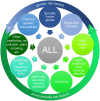Risk Factors for Childhood Leukemia: Radiation and Beyond
- PMID: 35004601
- PMCID: PMC8739478
- DOI: 10.3389/fpubh.2021.805757
Risk Factors for Childhood Leukemia: Radiation and Beyond
Abstract
Childhood leukemia (CL) is undoubtedly caused by a multifactorial process with genetic as well as environmental factors playing a role. But in spite of several efforts in a variety of scientific fields, the causes of the disease and the interplay of possible risk factors are still poorly understood. To push forward the research on the causes of CL, the German Federal Office for Radiation Protection has been organizing recurring international workshops since 2008 every two to three years. In November 2019 the 6th International Workshop on the Causes of CL was held in Freising and brought together experts from diverse disciplines. The workshop was divided into two main parts focusing on genetic and environmental risk factors, respectively. Two additional special sessions addressed the influence of natural background radiation on the risk of CL and the progress in the development of mouse models used for experimental studies on acute lymphoblastic leukemia, the most common form of leukemia worldwide. The workshop presentations highlighted the role of infections as environmental risk factor for CL, specifically for acute lymphoblastic leukemia. Major support comes from two mouse models, the Pax5+/- and Sca1-ETV6-RUNX1 mouse model, one of the major achievements made in the last years. Mice of both predisposed models only develop leukemia when exposed to common infections. These results emphasize the impact of gene-environment-interactions on the development of CL and warrant further investigation of such interactions - especially because genetic predisposition is detected with increasing frequency in CL. This article summarizes the workshop presentations and discusses the results in the context of the international literature.
Keywords: acute lymphoblastic leukemia; childhood leukemia; environmental exposure; genetic susceptibility; magnetic fields; radiation; risk factors.
Copyright © 2021 Schmidt, Hornhardt, Erdmann, Sánchez-García, Fischer, Schüz and Ziegelberger.
Conflict of interest statement
The authors declare that the research was conducted in the absence of any commercial or financial relationships that could be construed as a potential conflict of interest.
Figures

Similar articles
-
Novel ETV6-RUNX1 Mouse Model to Study the Role of ELF-MF in Childhood B-Acute Lymphoblastic Leukemia: a Pilot Study.Bioelectromagnetics. 2019 Jul;40(5):343-353. doi: 10.1002/bem.22193. Epub 2019 Jun 3. Bioelectromagnetics. 2019. PMID: 31157932
-
Rationale for an international consortium to study inherited genetic susceptibility to childhood acute lymphoblastic leukemia.Haematologica. 2011 Jul;96(7):1049-54. doi: 10.3324/haematol.2011.040121. Epub 2011 Apr 1. Haematologica. 2011. PMID: 21459794 Free PMC article. Review.
-
Identification of germline susceptibility loci in ETV6-RUNX1-rearranged childhood acute lymphoblastic leukemia.Leukemia. 2012 May;26(5):902-9. doi: 10.1038/leu.2011.302. Epub 2011 Nov 11. Leukemia. 2012. PMID: 22076464 Free PMC article.
-
The Eighth International Childhood Acute Lymphoblastic Leukemia Workshop ('Ponte di legno meeting') report: Vienna, Austria, April 27-28, 2005.Leukemia. 2006 Jan;20(1):9-17. doi: 10.1038/sj.leu.2404016. Leukemia. 2006. PMID: 16281070
-
Biology of childhood acute lymphoblastic leukemia.Pediatr Clin North Am. 2015 Feb;62(1):47-60. doi: 10.1016/j.pcl.2014.09.004. Pediatr Clin North Am. 2015. PMID: 25435111 Free PMC article. Review.
Cited by
-
Delayed diagnosis of advanced stage Leukemia in Two Pediatric Patients with Oral Manifestation.J Clin Exp Dent. 2023 Dec 1;15(12):e1060-e1063. doi: 10.4317/jced.61067. eCollection 2023 Dec. J Clin Exp Dent. 2023. PMID: 38186914 Free PMC article.
-
Global patterns of leukemia by subtype, age, and sex in 185 countries in 2022.Leukemia. 2025 Feb;39(2):412-419. doi: 10.1038/s41375-024-02452-y. Epub 2024 Nov 20. Leukemia. 2025. PMID: 39567675
-
Acute lymphoblastic leukaemia.Nat Rev Dis Primers. 2024 Jun 13;10(1):41. doi: 10.1038/s41572-024-00525-x. Nat Rev Dis Primers. 2024. PMID: 38871740 Review.
-
Prevalence and Treatment Outcomes of Childhood Acute Lymphoblastic Leukemia in Kosovo.Cancers (Basel). 2024 May 23;16(11):1988. doi: 10.3390/cancers16111988. Cancers (Basel). 2024. PMID: 38893109 Free PMC article.
-
Lessons from mouse models in the impact of risk factors on the genesis of childhood B-cell leukemia.Front Immunol. 2023 Oct 12;14:1285743. doi: 10.3389/fimmu.2023.1285743. eCollection 2023. Front Immunol. 2023. PMID: 37901253 Free PMC article. Review.
References
-
- Erdmann F, Kaatsch P, Grabow D, Spix C. German Childhood Cancer Registry - Annual Report 2019 (1980-2018). Mainz: Institute of Medical Biostatistics, Epidemiology and Informatics (IMBEI) at the University Medical Center of the Johannes Gutenberg University Mainz; (2020).
Publication types
MeSH terms
Grants and funding
LinkOut - more resources
Full Text Sources

